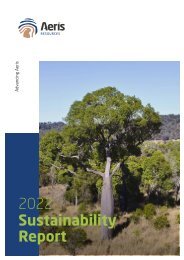Aeris Annual Report 2022
You also want an ePaper? Increase the reach of your titles
YUMPU automatically turns print PDFs into web optimized ePapers that Google loves.
<strong>Aeris</strong> Resources Limited<br />
Notes to the consolidated financial statements<br />
30 June <strong>2022</strong><br />
37. Significant accounting policies (continued)<br />
Investments and other financial assets<br />
Investments and other financial assets are initially measured at fair value. Transaction costs are included as part of the<br />
initial measurement, except for financial assets at fair value through profit or loss. Such assets are subsequently measured<br />
at either amortised cost or fair value depending on their classification. Classification is determined based on both the<br />
business model within which such assets are held and the contractual cash flow characteristics of the financial asset<br />
unless an accounting mismatch is being avoided.<br />
Financial assets are derecognised when the rights to receive cash flows have expired or have been transferred and the<br />
consolidated entity has transferred substantially all the risks and rewards of ownership. When there is no reasonable<br />
expectation of recovering part or all of a financial asset, it's carrying value is written off.<br />
Financial assets at amortised cost<br />
A financial asset is measured at amortised cost only if both of the following conditions are met: (i) it is held within a<br />
business model whose objective is to hold assets in order to collect contractual cash flows; and (ii) the contractual terms<br />
of the financial asset represent contractual cash flows that are solely payments of principal and interest.<br />
Financial assets at fair value through profit or loss<br />
Financial assets not measured at amortised cost or at fair value through other comprehensive income are classified as<br />
financial assets at fair value through profit or loss. Typically, such financial assets will be either: (i) held for trading, where<br />
they are acquired for the purpose of selling in the short-term with an intention of making a profit, or a derivative; or (ii)<br />
designated as such upon initial recognition where permitted. Fair value movements are recognised in profit or loss.<br />
Impairment of financial assets<br />
The consolidated entity recognises a loss allowance for expected credit losses on financial assets which are either<br />
measured at amortised cost or fair value through other comprehensive income. The measurement of the loss allowance<br />
depends upon the consolidated entity's assessment at the end of each reporting period as to whether the financial<br />
instrument's credit risk has increased significantly since initial recognition, based on reasonable and supportable<br />
information that is available, without undue cost or effort to obtain.<br />
Where there has not been a significant increase in exposure to credit risk since initial recognition, a 12-month expected<br />
credit loss allowance is estimated. This represents a portion of the asset's lifetime expected credit losses that is<br />
attributable to a default event that is possible within the next 12 months. Where a financial asset has become credit<br />
impaired or where it is determined that credit risk has increased significantly, the loss allowance is based on the asset's<br />
lifetime expected credit losses. The amount of expected credit loss recognised is measured on the basis of the probability<br />
weighted present value of anticipated cash shortfalls over the life of the instrument discounted at the original effective<br />
interest rate.<br />
For financial assets mandatorily measured at fair value through other comprehensive income, the loss allowance is<br />
recognised in other comprehensive income with a corresponding expense through profit or loss. In all other cases, the<br />
loss allowance reduces the asset's carrying value with a corresponding expense through profit or loss.<br />
Impairment of non-financial assets<br />
Non-financial assets are reviewed for impairment whenever events or changes in circumstances indicate that the carrying<br />
amount may not be recoverable. An impairment loss is recognised for the amount by which the asset's carrying amount<br />
exceeds its recoverable amount.<br />
Recoverable amount is the higher of an asset's fair value less costs of disposal and value-in-use. The value-in-use is the<br />
present value of the estimated future cash flows relating to the asset using a pre-tax discount rate specific to the asset<br />
or cash-generating unit to which the asset belongs. Assets that do not have independent cash flows are grouped together<br />
to form a cash-generating unit.<br />
Finance costs<br />
Finance costs attributable to qualifying assets are capitalised as part of the asset. All other finance costs are expensed in<br />
the period in which they are incurred.<br />
49<br />
ADVANCING AERIS<br />
125





